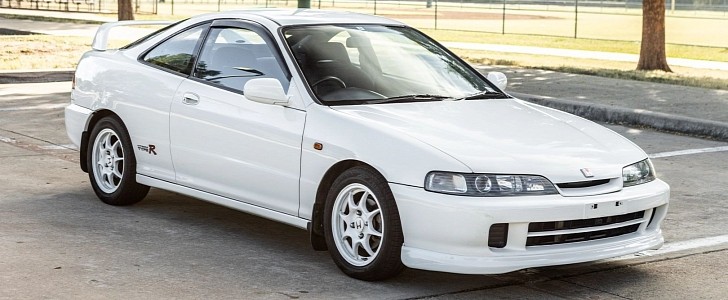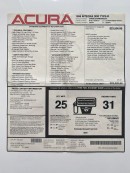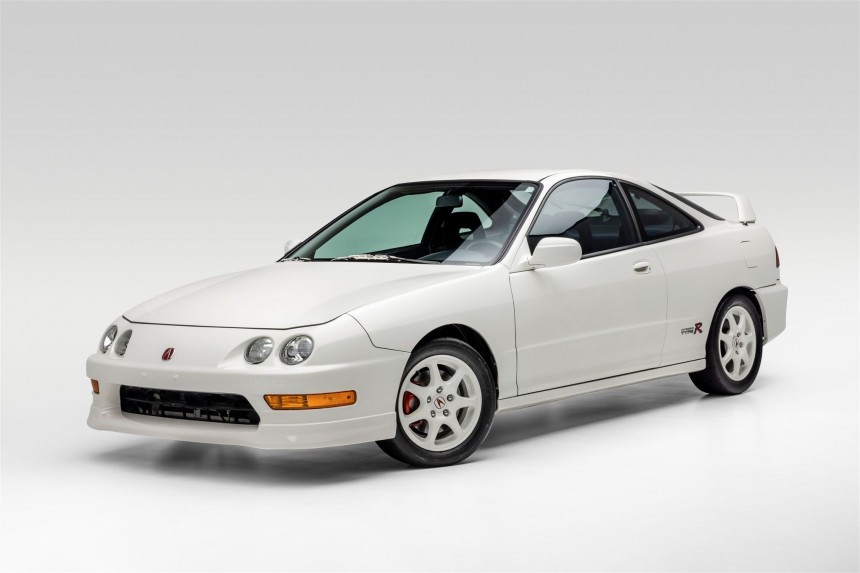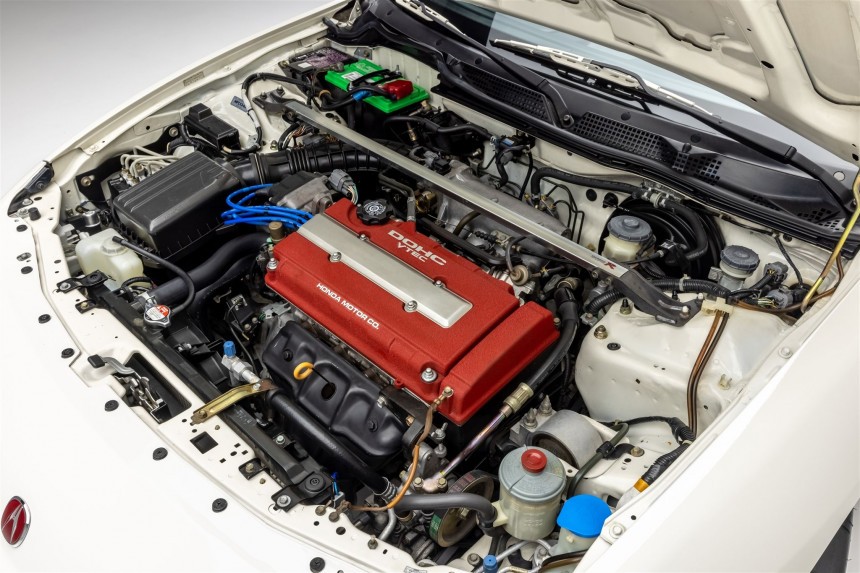R to Honda is like M to BMW. This letter signifies the finest-handling cars of the Japanese manufacturer, as well as the most powerful cars it produces. This designation rolled out in 1992 with the NSX Type R, followed by the automaker’s most celebrated front-driven model.
First of all, it’s of vital importance to understand what DC2 means, namely the VTEC-equipped Integra Type R from the model’s third generation. This codename was employed by two variants of the ITR, the JDM variant with rectangular-ish headlights and the USDM variant with round headlights.
An extremely rare variant of the Integra Type R is the DB8, which is pretty much a DC2 with two extra doors. The DC nomenclature was further applied to the fourth-generation Integra in the guise of the DC5. Over in the United States, it was marketed under the somewhat boring RSX moniker.
Now that we’ve covered this part of the story, a question must be posed. Why did the Japanese manufacturer and its Acura subsidiary award this coveted handle to the Integra? You can thank the NSX Type R for not selling too well. The commercial failure of the Type R-branded sports car made Honda realize that it’s better to liberalize the R with a more affordable model, and the Integra stood out as the best candidate at the time. But as you’re well aware, the Civic turned out to be Honda’s best-selling R ever.
A very different animal compared to the second-generation Integra Si, the third-generation Integra Type R isn’t for everyone. Starting with the shorter and stiffer springs, together with the anti-roll bars and strut braces, the R is anything but a daily driver. Honda reinforced the rear shock towers, strengthened the subframes, and gave the bodyshell a few more spot welds to increase torsional rigidity. The wheelbase, however, is unchanged from lesser Integras at 2,570 millimeters (101.2 in) from one axle to the other.
Gifted with double wishbones at every corner, the DC2 ITR further boasts improved camber control by means of stiffer bearings for the rear wheels. Stopping power comes in the guise of 262-mm ventilated front discs and 226-mm solid rear discs, backed up by specific tuning for the anti-lock braking system. Available in either Championship White or Gunmetal Gray, the light alloy wheels of the Integra Type R measure 15 by 6 inches.
Slightly wider in track than its non-Type R siblings, the Integra Type R was originally equipped with Bridgestone tires, which is only natural given that Bridgestone is a Japanese company. It’s also worth remembering that Bridgestone was interested in plastering its name pretty much everywhere outside of Japan back then, which led to its pairing with Scuderia Ferrari.
Tipping the scales at a little over 1,100 kilograms (2,425 pounds), the DC2 Integra Type R was initially offered in Championship White. Temporarily discontinued in the U.S. after the 1998 model year, the DC2 ITR was reintroduced for the 2000 model year with a new finish, Phoenix Yellow.
Nighthawk Black Pearl and Flamenco Black Pearl also need to be mentioned, along with Granada Black Pearl, Milano Red, and Vogue Silver Metallic. The Integra Type Rx, a final-year special edition that came with blue-tinted faux carbon inserts and electric folding mirrors, came with a stereo as standard. Prior ITRs could be optioned with a CD-playing head unit, plus air conditioning. The options list further consisted of an anti-lock braking system delete, power steering delete, and center console delete.
Upgraded with 16-inch wheels for the 1998 model year, the DC2 ITR also had its front discs enlarged to 282 millimeters. Honda further improved the breed with a four-to-one exhaust manifold and a higher final drive ratio, which dropped the peak torque from 7,500 to 6,200 revolutions per minute. For the 2000 model year, Honda revised the intake camshaft, the driveshafts, shock absorbers, and the interior. The beating heart of the DC2 ITR is the B18C four-cylinder VTEC engine, a masterpiece that originally produced 197 horsepower at 8,000 rpm and 133 pound-foot (181 Nm) at 7,500 rpm.
For the U.S. market where Acura called dibs on the DC2 Integra Type R, the three-door liftback belted out 195 horsepower and 130 lb-ft (176 Nm). It should be noted that U.S. models feature a lower compression ratio (10.6:1 compared to 11.1:1). VTEC activates lower in the rev range (5,700 rpm versus 6,000 rpm), and the redline is 100 rpm higher at 8,700 rpm.
Displacing 1,797 cubic centimeters thanks to an 81-mm bore and 87.2-mm stroke, the B18C rocks a polished and ported intake manifold, molybdenum-coated pistons, hand-torqued connection rods, a big-bore exhaust system, thin-stem valves, and an eight-counterweight crankshaft. The only transmission available was a five-speed manual with a close-ratio design, connected to a front limited-slip differential of the helical variety.
Japanese automakers usually keep many records of pretty much everything, but on the other hand, nobody is certain how many DC2 ITRs were built. Manufactured between 1995 and 2000, the DC2 Integra Type R and the four-door DB8 Integra Type R are believed to have sold 29,995 units in Japan. Only 3,850 examples were built for the U.S. market from the 1997 model year to 1998 and 2000 to 2001. A few thousand more units were delivered in other countries, including 500 RHD examples for the United Kingdom.
An extremely rare variant of the Integra Type R is the DB8, which is pretty much a DC2 with two extra doors. The DC nomenclature was further applied to the fourth-generation Integra in the guise of the DC5. Over in the United States, it was marketed under the somewhat boring RSX moniker.
Now that we’ve covered this part of the story, a question must be posed. Why did the Japanese manufacturer and its Acura subsidiary award this coveted handle to the Integra? You can thank the NSX Type R for not selling too well. The commercial failure of the Type R-branded sports car made Honda realize that it’s better to liberalize the R with a more affordable model, and the Integra stood out as the best candidate at the time. But as you’re well aware, the Civic turned out to be Honda’s best-selling R ever.
A very different animal compared to the second-generation Integra Si, the third-generation Integra Type R isn’t for everyone. Starting with the shorter and stiffer springs, together with the anti-roll bars and strut braces, the R is anything but a daily driver. Honda reinforced the rear shock towers, strengthened the subframes, and gave the bodyshell a few more spot welds to increase torsional rigidity. The wheelbase, however, is unchanged from lesser Integras at 2,570 millimeters (101.2 in) from one axle to the other.
Slightly wider in track than its non-Type R siblings, the Integra Type R was originally equipped with Bridgestone tires, which is only natural given that Bridgestone is a Japanese company. It’s also worth remembering that Bridgestone was interested in plastering its name pretty much everywhere outside of Japan back then, which led to its pairing with Scuderia Ferrari.
Tipping the scales at a little over 1,100 kilograms (2,425 pounds), the DC2 Integra Type R was initially offered in Championship White. Temporarily discontinued in the U.S. after the 1998 model year, the DC2 ITR was reintroduced for the 2000 model year with a new finish, Phoenix Yellow.
Nighthawk Black Pearl and Flamenco Black Pearl also need to be mentioned, along with Granada Black Pearl, Milano Red, and Vogue Silver Metallic. The Integra Type Rx, a final-year special edition that came with blue-tinted faux carbon inserts and electric folding mirrors, came with a stereo as standard. Prior ITRs could be optioned with a CD-playing head unit, plus air conditioning. The options list further consisted of an anti-lock braking system delete, power steering delete, and center console delete.
For the U.S. market where Acura called dibs on the DC2 Integra Type R, the three-door liftback belted out 195 horsepower and 130 lb-ft (176 Nm). It should be noted that U.S. models feature a lower compression ratio (10.6:1 compared to 11.1:1). VTEC activates lower in the rev range (5,700 rpm versus 6,000 rpm), and the redline is 100 rpm higher at 8,700 rpm.
Displacing 1,797 cubic centimeters thanks to an 81-mm bore and 87.2-mm stroke, the B18C rocks a polished and ported intake manifold, molybdenum-coated pistons, hand-torqued connection rods, a big-bore exhaust system, thin-stem valves, and an eight-counterweight crankshaft. The only transmission available was a five-speed manual with a close-ratio design, connected to a front limited-slip differential of the helical variety.
Japanese automakers usually keep many records of pretty much everything, but on the other hand, nobody is certain how many DC2 ITRs were built. Manufactured between 1995 and 2000, the DC2 Integra Type R and the four-door DB8 Integra Type R are believed to have sold 29,995 units in Japan. Only 3,850 examples were built for the U.S. market from the 1997 model year to 1998 and 2000 to 2001. A few thousand more units were delivered in other countries, including 500 RHD examples for the United Kingdom.



























































